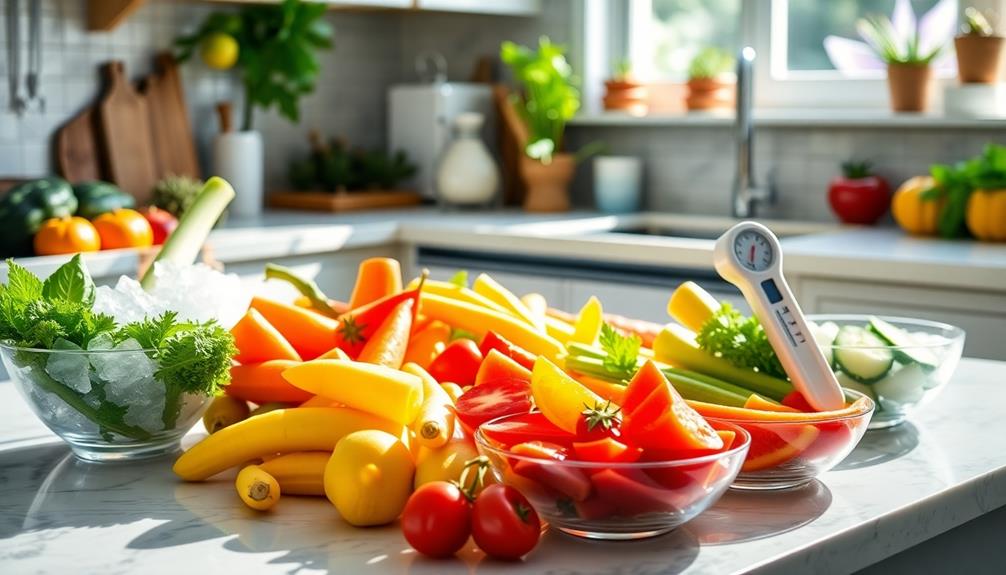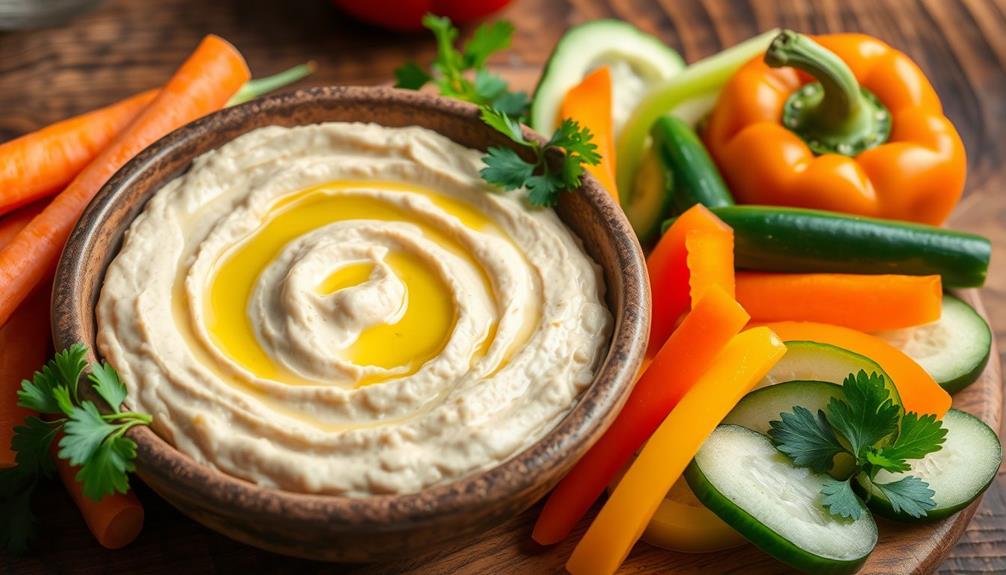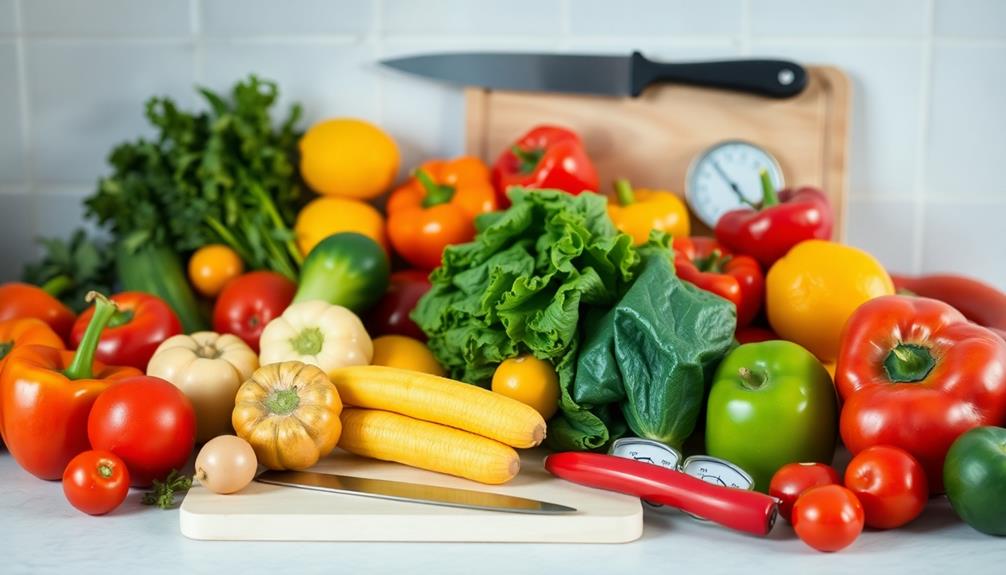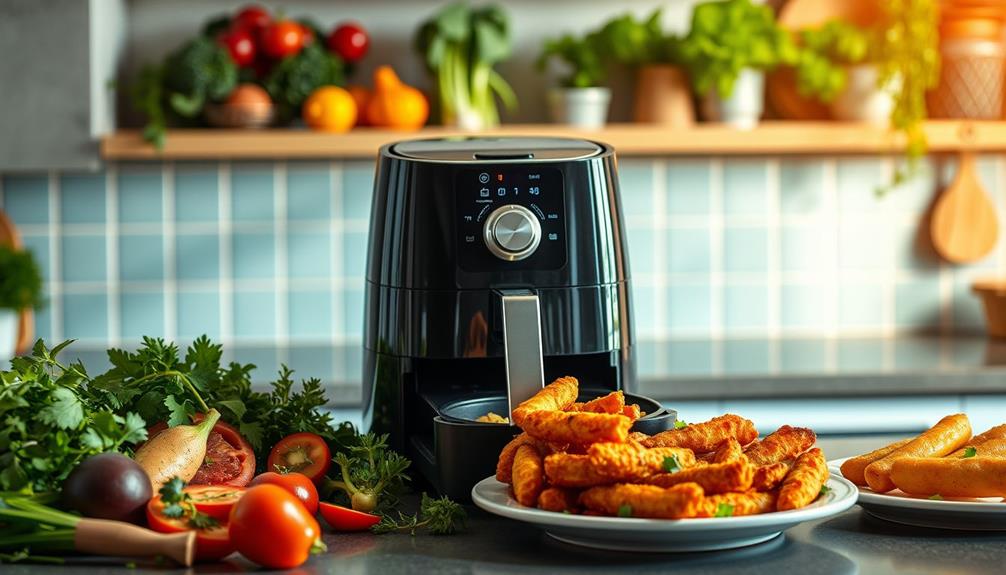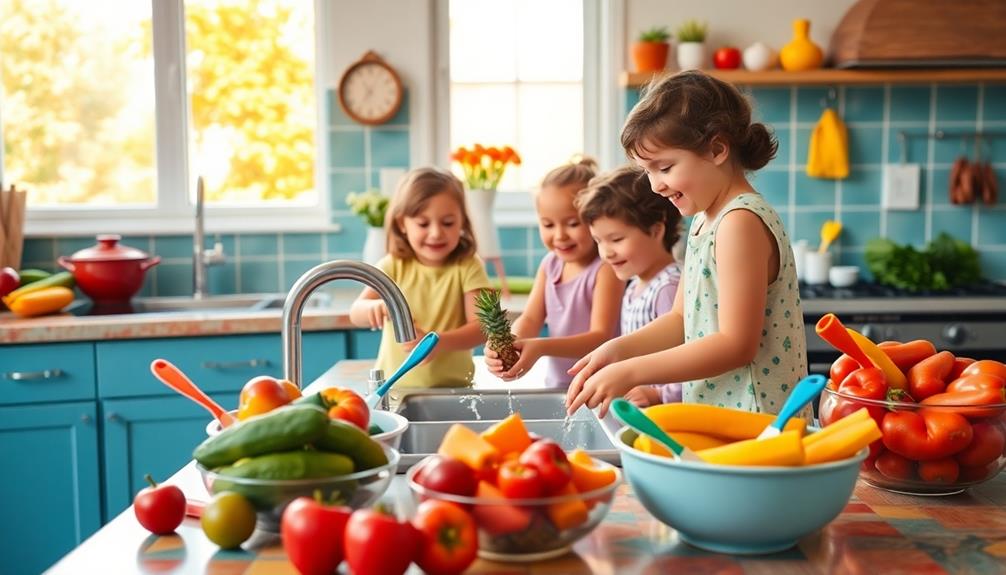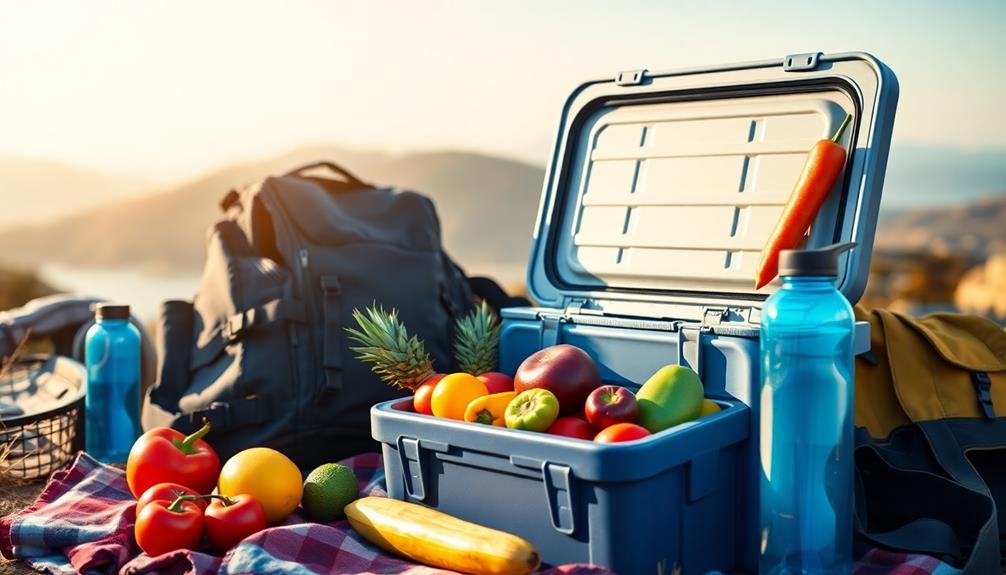Keeping raw food safe during summer is essential to avoid foodborne illnesses. Always wash your hands with warm, soapy water for at least 20 seconds before handling food. Use separate cutting boards for raw meats and ready-to-eat foods to prevent cross-contamination. Make sure to cook meat to the right temperatures—165°F for poultry and 160°F for ground beef. Store perishables promptly, refrigerating within two hours, and keep your fridge below 40°F. When grilling, maintain a safe distance for raw and cooked items. There's plenty more to discover about food safety practices you can adopt this summer.
Key Takeaways
- Always wash hands with warm, soapy water for at least 20 seconds before and during food preparation to prevent cross-contamination.
- Use separate cutting boards and utensils for raw meats and ready-to-eat foods to avoid pathogen transfer.
- Cook foods to safe internal temperatures: poultry at 165°F and ground meats at 160°F, using a food thermometer.
- Refrigerate perishable items within two hours and keep your refrigerator at or below 40°F to slow bacterial growth.
- Rinse fruits and vegetables under running water for at least 20 seconds to remove harmful microorganisms before consumption.
Importance of Food Safety
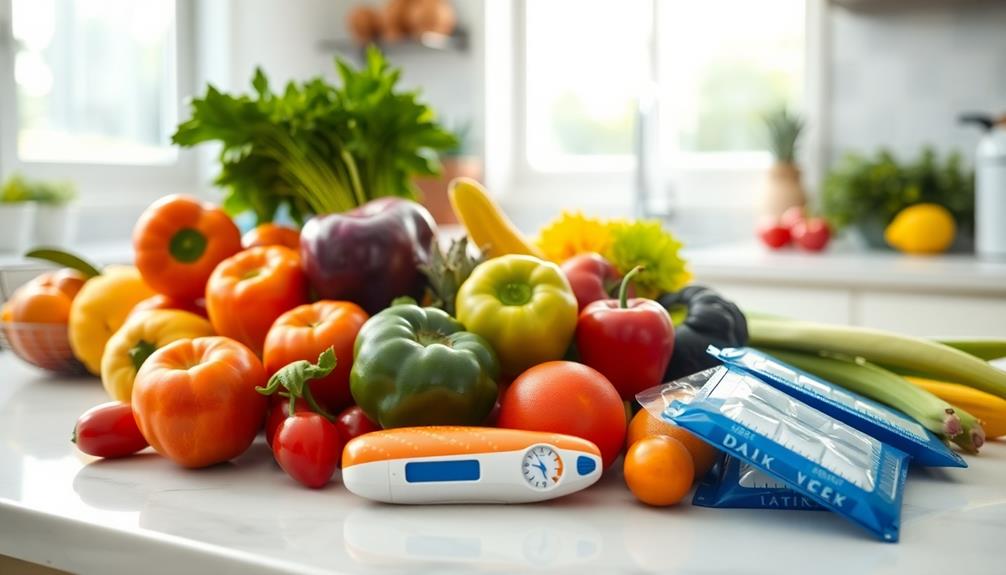
Food safety is vital, especially during the summer months when the risk of foodborne illnesses skyrockets. With around 48 million Americans experiencing food poisoning each year, you're at a higher risk when temperatures rise. The warm weather creates perfect conditions for pathogens like Salmonella and E. coli to thrive, making it essential to practice safe food handling.
When you're handling raw foods, always wash your hands thoroughly before and after. This simple step can greatly reduce contamination risks.
Also, keep an eye on safe temperatures; raw meat should be cooked to the appropriate internal temperature to eliminate harmful bacteria. For example, ground beef needs to reach at least 160°F, while poultry should hit 165°F.
Make sure to store perishable items promptly and avoid leaving them out in the heat. Pay attention to food safety guidelines to protect yourself and your loved ones from serious health risks.
Hand and Surface Hygiene
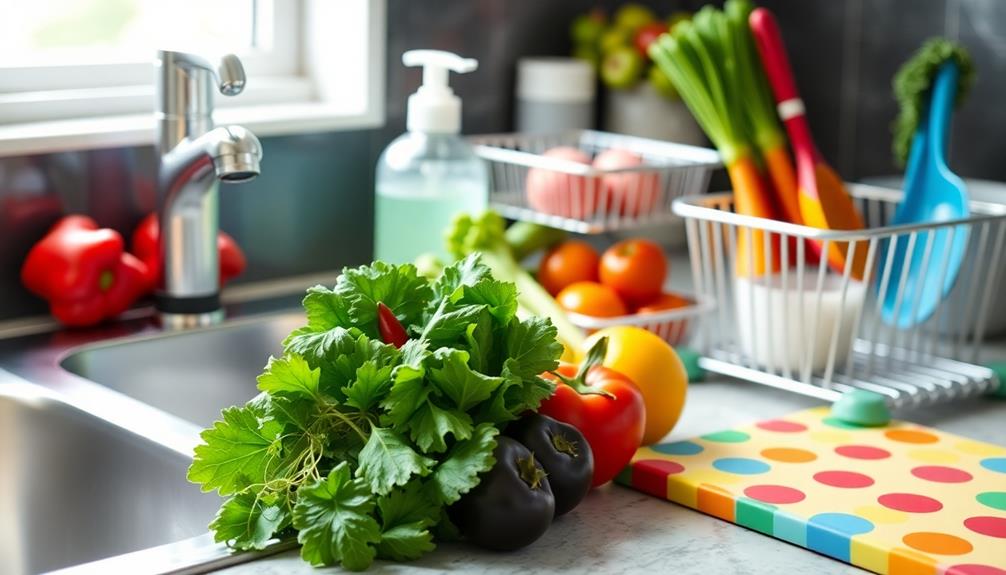
When preparing raw foods, your handwashing routine is essential for safety. Make sure you wash your hands frequently with warm, soapy water for at least 20 seconds, especially after handling potentially contaminated items.
Additionally, maintaining a clean environment is important; consider using specialized cleaning tools to enhance your efforts, such as vacuum cleaner attachments that can help eliminate dust and allergens from surfaces.
Don't forget to sanitize your surfaces too, as clean countertops and utensils help prevent the spread of harmful bacteria.
Importance of Handwashing
Handwashing is essential in preventing foodborne illnesses, especially during the summer months when raw food preparation is common. When you're handling food, you can easily transfer harmful bacteria from your hands to the ingredients if you don't take proper precautions.
Always wash your hands with warm, soapy water for at least 20 seconds before and during food preparation. This simple step considerably reduces the risk of foodborne illness.
It's also important to wash your hands after using the bathroom, changing diapers, or handling pets. These activities can introduce harmful microorganisms that could contaminate your food.
The CDC emphasizes that unwashed hands are a primary cause of foodborne illness, so maintaining consistent hand hygiene is essential.
When soap and safe water aren't available, consider using disposable hand wipes as a practical alternative. They can help maintain hand hygiene, especially while enjoying outdoor activities.
Remember, effective handwashing is your first line of defense against foodborne illnesses. So, wash hands and surfaces diligently to keep your food safe and reduce the risk of cross-contamination.
Taking these precautions will guarantee you and your loved ones stay healthy this summer.
Surface Sanitization Techniques
To maintain a safe cooking environment, regularly sanitizing surfaces is vital, especially during summer months when food prep increases.
Start by washing your hands frequently with warm, soapy water for at least 20 seconds before and after handling food. This step minimizes the transfer of harmful microorganisms that can cause food poisoning.
Next, focus on sanitizing countertops, cutting boards, and utensils. After you handle raw meats, it's important to sanitize these surfaces to prevent cross-contamination.
If soap and hot water aren't available, use effective disposable wipes or sanitizing sprays designed to eliminate bacteria.
Before you begin preparing food, verify all surfaces are cleaned and sanitized.
Remember, unclean surfaces can harbor bacteria that contaminate your meals, increasing the risk of foodborne illnesses.
Also, don't forget to wash your hands after using the bathroom, changing diapers, or touching pets, as these actions can introduce pathogens that compromise food safety.
Disposable Wipe Usage
Maintaining hygiene while preparing raw foods can be challenging, especially outdoors during summer.
Disposable wipes can serve as a temporary alternative for hand hygiene when soap and hot water aren't available. It's crucial to choose antibacterial wipes to effectively reduce harmful microorganisms that lead to contamination.
Here are some tips for using disposable wipes effectively:
- Always check for antibacterial labeling to verify effectiveness.
- Follow the manufacturer's instructions for best usage.
- Use a fresh disposable wipe for each cleaning task.
- Wipe down your hands and surfaces thoroughly.
- Wash your hands with soap and water as soon as possible after using wipes.
Preventing Cross-Contamination
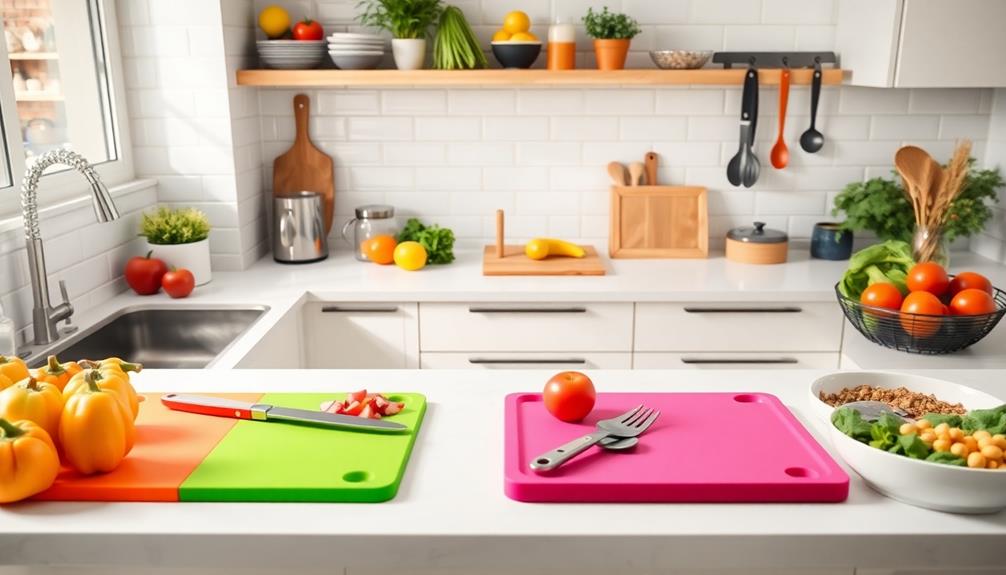
To prevent cross-contamination, start by securely packaging raw meat and using separate cutting boards and utensils for different food types.
Make sure to wash your hands frequently, especially after handling raw items, to keep harmful bacteria at bay.
Secure Raw Meat Packaging
Securing raw meat packaging is essential for preventing cross-contamination in your kitchen. Proper packaging protects perishable foods from harmful bacteria and helps you maintain a safe internal cooking environment.
Here are some key steps to follow:
- Always use leak-proof containers or tightly wrapped plastic to keep raw meat juices contained.
- Store raw meat at the bottom of your cooler to prevent drips onto ready-to-eat foods.
- Label each package with the date and type of meat for easy identification and safe handling.
- Use separate shopping bags for raw meats to minimize contact with other grocery items during transport.
- Regularly check that the packaging is intact and avoid buying any with damaged seals to prevent foodborne illnesses.
Separate Utensils and Boards
Cross-contamination is a serious risk when preparing raw foods, especially in the summer heat. To maintain a safe food preparation environment, it's essential to use separate cutting boards and utensils for raw meat or poultry versus ready-to-eat foods. This practice prevents harmful pathogens from transferring between surfaces.
Here's a quick reference table to help you remember:
| Item | Usage |
|---|---|
| Red Cutting Board | Raw meat and poultry |
| Green Cutting Board | Vegetables and fruits |
| Blue Cutting Board | Seafood |
| Utensils for Raw Meat | For handling raw meat |
| Clean Utensils | For cooked or ready-to-eat foods |
Designate specific utensils for raw meat, and always wash them thoroughly before using them on cooked items. Color-coding your boards and utensils can make it easier to remember which ones are for raw ingredients. Additionally, regularly sanitize surfaces that come into contact with raw foods to eliminate any lingering pathogens. By taking these simple precautions, you can notably reduce the risk of cross-contamination in your kitchen during the summer months.
Wash Hands Frequently
Maintaining a safe kitchen goes beyond using separate utensils and boards; frequent handwashing is an essential step in preventing cross-contamination. To reduce the risk of transferring harmful bacteria, you should wash your hands with warm, soapy water for at least 20 seconds before and after handling raw foods.
It's important to establish a routine during food preparation, especially in the summer when bacteria thrive. Remember to wash hands:
- After using the bathroom
- After changing diapers
- After touching pets
- Before eating or serving food
- Before and after preparing raw foods
If soap and water aren't available, use disposable hand wipes or moist towelettes as a temporary measure, but prioritize proper handwashing whenever possible.
Regularly sanitize your countertops, cutting boards, and utensils that come into contact with raw foods to eliminate lingering pathogens. Unwashed hands are a primary cause of foodborne illness, making it essential to keep this habit strong and consistent.
Safe Cooking Practices
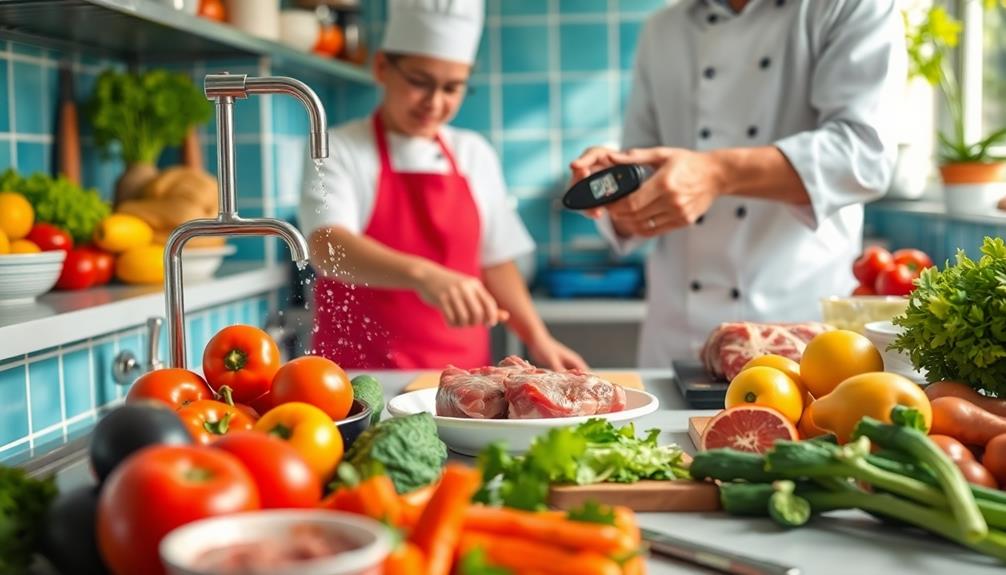
To guarantee your meals are safe and delicious, follow essential cooking practices that minimize the risk of foodborne illnesses. Always use a food thermometer to verify that meats are cooked to their safe internal temperatures—165°F for poultry and 160°F for ground meats. This step is vital for eliminating harmful bacteria that can cause serious health issues.
Avoid the temptation to partially cook food in advance, as this can allow bacteria to survive and multiply. When preparing soups and stews, make sure they reach a boiling point, effectively killing any potential pathogens present.
Reheating leftovers is equally important. Confirm they reach a steaming hot temperature of 165°F before you dig in. This practice helps safeguard against foodborne illnesses that can arise from improperly reheated food.
Lastly, resist the urge to taste raw food during the cooking process. Doing so can transfer harmful microorganisms from uncooked ingredients to your prepared dishes.
Proper Food Storage
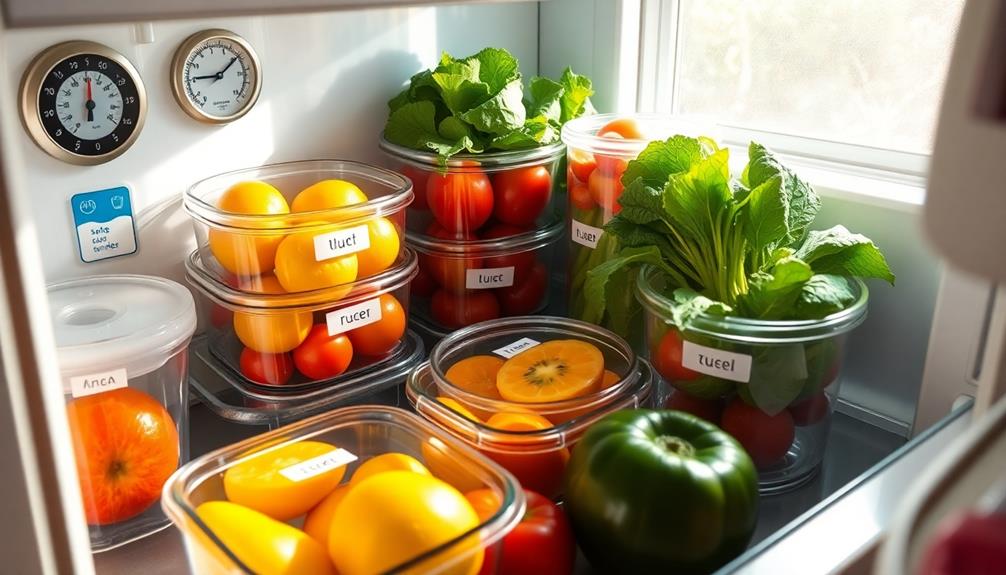
After ensuring your food is cooked safely, proper storage is the next critical step in preventing foodborne illnesses. You must pay attention to how you handle and store perishable items.
To maintain food safety, follow these guidelines:
- Refrigerate perishable foods within two hours, or one hour if the temperature exceeds 90°F (32°C).
- Keep your refrigerator at or below 40°F (4°C) and your freezer at 0°F (-18°C) to slow bacterial growth.
- Divide large quantities of warm food into shallow containers for quicker chilling.
- Use airtight containers for leftovers and label them with dates to monitor freshness.
- Thaw frozen foods only in the refrigerator, cold water, or microwave—never at room temperature.
Outdoor and Grilling Safety

When you're grilling outdoors, safety should be top of mind to guarantee a fun and healthy experience. To minimize the risk of foodborne illnesses, it's vital to keep raw meat and ready-to-eat foods separate. Use distinct utensils and plates for each to prevent cross-contamination.
Always preheat your grill for 20 to 30 minutes until the coals are lightly coated with ash. This guarantees even cooking and reduces the chances of undercooked food.
As you grill, don't forget to use a food thermometer. Make certain hamburgers reach an internal temperature of 160°F, poultry hits 165°F, and fish flakes easily when done.
In warm weather, it's important to keep an eye on food safety. If temperatures exceed 90°F, refrigerate any perishable items within one hour to inhibit bacterial growth. Use insulated coolers with ice packs to keep everything chilled.
Safe Water and Food Selection
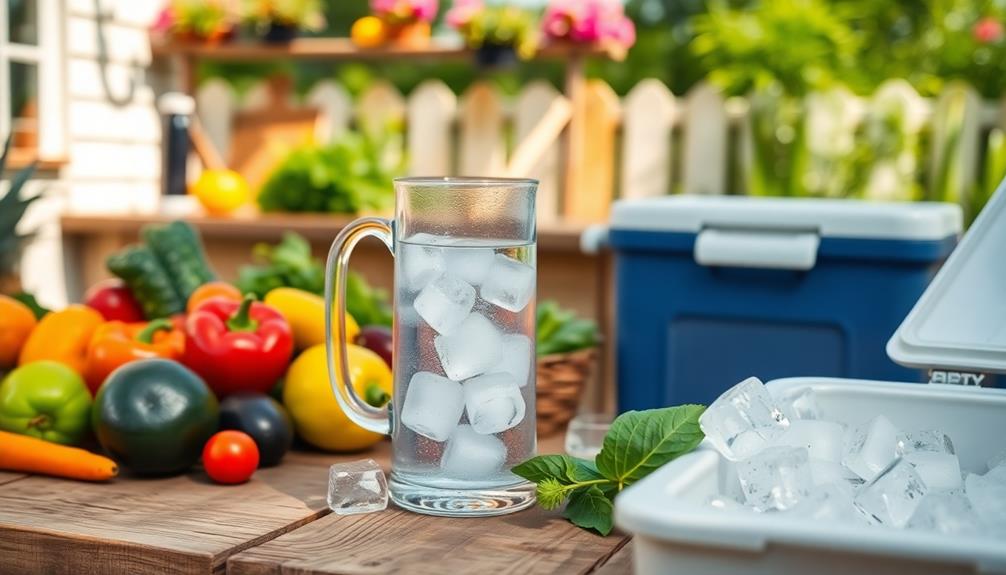
Grilling outdoors can be a blast, but food safety doesn't stop when you step away from the grill. To guarantee you're keeping your meals safe this summer, focus on using potable water and selecting the right foods. Contaminated water can introduce harmful microorganisms, especially in warm weather, so always wash your fruits and vegetables with safe water.
Here are some quick tips for safe food selection:
- Choose fresh, wholesome foods from reputable sources.
- Rinse raw produce under running water for at least 20 seconds.
- Pay attention to use-by dates on all food products.
- Opt for pasteurized dairy and juices to reduce foodborne risks.
- Avoid unprocessed items that may harbor pathogens.
Frequently Asked Questions
How to Keep Food Safe in Summer?
To keep food safe in summer, refrigerate perishables within two hours, use separate coolers for food and drinks, maintain temperatures below 40°F, and always wash your hands after handling raw items.
Do Foodborne Illnesses Increase in the Summer Months?
Yes, foodborne illnesses do increase in summer. Higher temperatures create ideal conditions for bacteria to thrive. You should be cautious with food handling and storage to minimize risks during picnics and outdoor gatherings.
Is Food Safe in Hot Weather?
Food's not always safe in hot weather. Bacteria thrive in warm temperatures, so you must keep perishable items refrigerated and avoid leaving them out too long. Always monitor temperatures to guarantee everything stays safe for consumption.
What Temperature Should Raw Food Be Kept At?
Raw food should be kept below 40°F (4°C) to prevent bacterial growth. Always check your refrigerator's temperature, and verify perishable items aren't left unrefrigerated for more than two hours, especially in warmer conditions.
Conclusion
As summer heats up, the importance of raw food safety can't be overstated. With family barbecues and picnics around the corner, taking simple precautions can protect your loved ones from foodborne illnesses. Remember, a little vigilance goes a long way—don't let a moment of negligence spoil your summer fun. By practicing good hygiene, preventing cross-contamination, and ensuring proper food storage, you can savor every delicious bite without worry. Safety is the key to a joyful summer feast!

